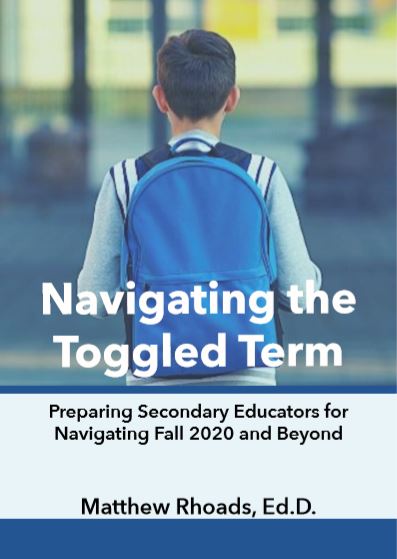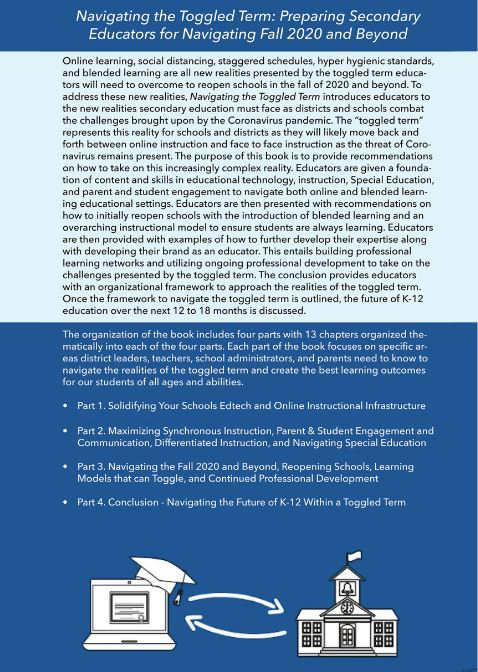
Get your copy today of “Navigating the Toggled Term” to create the best instructional solutions for your classroom, school, or district for the 2020-2021 school year and beyond.
About the book: Navigating the toggled term – Preparing secondary educators for navigating fall 2020 and beyond
Testimonials
- Conceptualizing the return to school after a pandemic is a challenge. Dr. Rhoads provides exceptional ideas and solutions for educators to consider. As a transformational leader and secondary educator, he gives sound advice on how to solidify online instructional infrastructure, maximize instruction, support the needs of all learners, provide professional learning for the educators, and reopen schools that provide a safe, innovative learning environment. This book is a practical roadmap for navigating the challenge of reopening schools. Belinda Dunnick Karge, Ph.D., Professor Doctoral Programs, Concordia University Irvine and Professor Emeritus California State University, Fullerton
- Dr. Rhoads offers concrete and real-life examples within an evidence-based framework to provide common-sense solutions for an unpredictable semester ahead. The easy-to-follow steps will prepare you for the inevitable challenges in K-12 education faced as a result of the COVID-19 pandemic. With an eye toward the future, Dr. Rhoads shows how the innovation of today can pivot into a roadmap for the personalized learning of tomorrow. Jill, University Education Program Director
Online learning, social distancing, staggered schedules, hyper hygienic standards, and blended learning are all new realities presented by the toggled term educators will need to overcome to reopen schools in the fall of 2020 and beyond. To address these new realities, Navigating the Toggled Term introduces educators to the new realities secondary education must face as districts and schools combat the challenges brought upon by the Coronavirus pandemic. The “toggled term” represents this reality for schools and districts as they will likely move back and forth between online instruction and face to face instruction as the threat of Coronavirus remains present. The purpose of this book is to provide recommendations on how to take on this increasingly complex reality. Educators are given a foundation of content and skills in educational technology, instruction, Special Education, and parent and student engagement to navigate both online and blended learning educational settings. Educators are then presented with recommendations on how to initially reopen schools with the introduction of blended learning and an overarching instructional model to ensure students are always learning. Educators are then provided with examples of how to further develop their expertise along with developing their brand as an educator. This entails building professional learning networks and utilizing ongoing professional development to take on the challenges presented by the toggled term. The conclusion provides educators with an organizational framework to approach the realities of the toggled term. Once the framework to navigate the toggled term is outlined, the future of K-12 education over the next 12 to 18 months is discussed.
The organization of the book includes four parts with thirteen chapters organized thematically into each of the four parts. Each part of the book focuses on specific areas district leaders, teachers, school administrators, and parents need to know to navigate the realities of the toggled term and create the best learning outcomes for our students of all ages and abilities.
Part 1. Solidifying Your Schools Edtech and Online Instructional Infrastructure
- Selecting Edtech Tools for your Online and Blended Learning Classroom
- EdTech Tools to Get You Started with Your Online and Blended Teaching! Start Now!
- Steps to Building Your Online Classroom for K-12 Educators
- Implementing Instructional Strategies and Lesson Plans with Edtech and your Online Classrooms
Part 2. Maximizing Synchronous Instruction, Parent & Student Engagement and Communication, Differentiated Instruction, and Navigating Special Education
- Maximizing Live Synchronous Class Sessions and Google Meet – Strategies to Help Bolster Your Students Online Learning
- Student and Parental Engagement for Online Learning – Building Community Online through Edtech
- Differentiated Instruction: Online Instruction for Special Education and English Language Learners
- Case Management for Special Education for Online and Blended Learning Settings
- IEP Meetings During a Toggled Term – Recommendations for Preparing and Conducting Effective Online IEP Meetings
Part 3. Navigating the Fall 2020 and Beyond, Reopening Schools, Learning Models that can Toggle, and Continued Professional Development
- The Initial Reopening of K-12 Schools in the Fall of 2020 – Priorities to Assess, Students with Special Needs, and Staggered Schedules
- Blended Learning is the Future – Types of Blended Learning Models for Fall 2020
- A Learning Model that can Toggle – A Model Simultaneous and Continuous Online, Blended, and In-Person Learning
- Professional Learning as an Educator Using Social Media – Your Social Knowledge Network is Your Net Worth
Part 4. Conclusion – Navigating the Future of K-12 Within a Toggled Term
Be prepared to plan and refine your instructional plans to create the best solutions for your students as we navigate the “toggled term.”
“Navigating the Toggled Term” will help teachers and admin in the following areas:
- Prepares teachers and admin to toggle their instruction between online, blended, and traditional educational settings.
- Introduces teachers and admin to the “Toggled Term Instructional Model.”
- An organizational framework is provided on how schools can navigate the “toggled term.”
- Provides step by step instructions to create an online instructional infrastructure that can be used to deliver instruction in online, blended, and traditional educational settings.
- Outlines Blended Learning and HyFlex instructional models and their application to K-12 settings.
- Illustrates how to implement staggered schedules and the cohort model for blended/hybrid learning models.
- Learn about various edtech tools and their applications.
- Provides a step by step process to select the right edtech tools to meet your students where they are at.
- Outlines how to differentiate instruction using edtech.
- Best practices for online synchronous and asynchronous instruction are provided.
- Student and parental communication and engagement practices are summarized.
- Illustrates how to conduct IEP meetings online and case manage students with special needs during a “toggled term.”
- Provides a thorough guide on how to conduct professional development and to build an educator’s brand.

“Create interchangeable and seamless 24/7 learning instructional models that can toggle between educational settings regardless of whether the physical brick and mortar school building can be open.”
Matthew Rhoads, Ed.D.
Purchase your copy of Navigating the Toggled Term on Amazon.com
Amazon Paperback – Click Here!
Testimonial
As a classroom teacher who integrates educational technology on a daily basis, I enjoyed reading Dr.Rhoads’ book, Navigating the Toggled Term: Preparing Secondary Educators for Navigating Fall 2020 and Beyond. I really enjoyed Chapter 1: Selecting Edtech Tools for your Online and Blended Learning Classroom. When I think of all the amazing educational technology tools out there, I at times struggle to figure out which ones will produce the best student outcomes and the importance of reflecting after the tool has been integrated. Having read this chapter helped me use Dr. Rhoad’s five-step process in selecting my own educational tools. This has allowed me to evaluate tools and make the best decisions based on a very detailed and reflective process. Also, as a visual learner, I enjoyed the tables on pages 20-22 which game me a graphic organizer to help the selection process.’
Laura, Edtech Expert and Middle School Educator
Testimonial
Thank you for this insightful book. Implementing your suggestions on how to effectively set up synchronous and asynchronous classes has saved me countless time and frustration. Based on your clear guidance and expertise, I have created interactive and engaging courses for students in the areas of social justice, restorative practices, and peer mediation. I found all chapters of your book to be relevant, useful, concise, and beneficial to my lesson planning and virtual classroom set up. I appreciate your understanding of the challenges faced by K-12 educators during this time and your willingness to be of contribution to your peers during this transitional period.
Malikah, Middle School Restorative Justice Teacher Advisor
Testimonial
Dr. Rhoads applies research-based strategies to real-world schools and classrooms to create a road map to reopening our public schools. This book addresses not only the why of returning to campus but offers a tangible road map for district and site administrators and classroom teachers as they navigate this unprecedented challenge. The four key themes address the following: 1) Solidifying Your District and Schools Edtech and Online Instructional Infrastructure, 2) Maximizing Synchronous Instruction, Parent & Student Engagement and Communication, Differentiated Instruction, and Navigating Special Education, 3) Navigating Fall 2020 and Beyond, Reopening Schools, Learning Models that can Toggle, and Continued Professional Development, and 4) Toggling the School Year, Navigating In-Person and Online learning throughout the year. Rather than simply identifying the problem, the author provides a roadmap and structures for teams to use to create the site and district-specific plans to reopen safely this fall.
Janet, Program Manager of a Secondary Independent Study Program